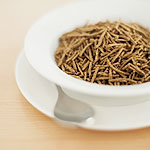 In the next part of my series on type 2 diabetes, I look at the evidence behind using fiber to control your blood glucose levels. Overall, there is good news here.
In the next part of my series on type 2 diabetes, I look at the evidence behind using fiber to control your blood glucose levels. Overall, there is good news here.
In all, fiber lowers blood glucose by either blocking glucose absorption from the gut and/or increasing the transit time through the gut. The studies mentioned below involve several forms of fiber. Psyllium is a soluble fiber from a shrub-like herb called “Plantago.” Guar gum is a water-soluble fiber that comes from guar seeds, grown mostly in India and Pakistan. Glucommannan, which comes from the konjac plant mostly grown in China, is used as a dietary fiber. Fiber supplements come in tablets, capsules and powder.
A few studies show that fiber has a positive effect on HbA1C in type 2 diabetes. (Recall that this is a form of hemoglobin that reflects the average blood glucose levels over the past 90 days.)
One study involved 17 insulin-dependent type 1 diabetic patients who were randomized to receive either guar gum (five grams daily) or placebo for six weeks. HbA1C in guar-gum-treated patients decreased by 0.6% vs. 0.5% in placebo-treated patients. Fasting blood glucose in guar-gum-treated patients decreased 1.7 millimoles/liter (mmol/L) vs. an increase of 0.3 mmol/L in placebo patients. Total cholesterol in guar-gum-treated patients decreased 1.0 mmol/L vs. a 0.1-mmol/L decrease in the placebo group.
Another study involved 49 type 2 diabetic patients who were assigned to receive 5.1 grams twice a day of psyllium husk fiber or placebo while they continued taking anti-diabetic drugs for eight weeks. Here, psyllium led to a significant drop in fasting blood glucose — 53 milligrams per deciliter (mg/dL) vs. 31 mg/dL by placebo. Also, psyllium-treated patients showed a significant lowering of HbA1C of 1.4% vs. an increase of 1.4% in placebo.
Many studies show fiber having beneficial effects on blood glucose levels.
In one study, 34 men with type 2 diabetes with high cholesterol received 5.1 gram psyllium or placebo for eight weeks. The all-day blood glucose was 11% lower and post-lunch blood glucose was 19% lower in the psyllium group. As compared to the placebo group, total and LDL cholesterol levels were 8.9% and 13% lower, respectively, in the psyllium group.
A total of 14 studies have shown that glucommannan dropped fasting blood glucose by 7.44 mg/dL, body weight by 0.79 kg, total cholesterol by 19.28 mg/dl, LDL cholesterol by 15.99 mg/dL, and triglycerides by 11.08 mg/dL.
The American Diabetes Association recommends that all diabetic patients get 14 grams per 1,000 kilocalories/day of fiber in order to improve their blood sugar control. You should always take your fiber supplement with a full eight-ounce glass of water and drink at least six to eight glasses of water a day. And you should take fiber supplements at least one hour before or two to four hours after taking other medications.
Here are the previous articles in this series:
An Inside Look at Diabetes
How Effective Are Drugs for Diabetes?
The Ultimate Mineral for Diabetes
Should You Take Cinnamon for Diabetes?
